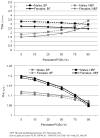Relationships of putative endocrine disruptors to human sexual maturation and thyroid activity in youth
- PMID: 19800354
- PMCID: PMC2813917
- DOI: 10.1016/j.physbeh.2009.09.015
Relationships of putative endocrine disruptors to human sexual maturation and thyroid activity in youth
Abstract
Endocrine disruption has become a significant human health concern, but is difficult to study outside of the laboratory for several reasons including the multiplicity of exposures, the difficulty in assessing each exposure, and the variety of possible outcomes among human populations. This review summarizes our studies of the relationships of measured persistent organic pollutants (PCBs, p,p'-DDE, HCB and mirex), and heavy metals (lead and mercury), to outcomes directly related to thyroid function and sexual maturation. These studies were conducted in a sample of Native American youth from the Akwesasne Mohawk community. The participants were first studied during puberty (10-16.9 years of age) and then at approximately 18 years of age. Results from these studies show that PCB levels are positively related to TSH and negatively to free T4. Further, these effects are conditioned by breastfeeding history. Anti-thyroid peroxidase antibody levels also are related to PCB levels suggesting elevated risk of autoimmune disease among the exposed. Earlier age at menarche is associated with higher PCB levels while risk of delay is associated with higher lead levels. Some evidence that the timing of exposure produces different effects is presented, and the level of exposure in the participants suggests that effects observed may be relevant to a considerable proportion of the US population. Further investigations are warranted to determine effect thresholds and mechanisms.
2009 Elsevier Inc. All rights reserved.
Figures




Similar articles
-
Relationship of lead, mercury, mirex, dichlorodiphenyldichloroethylene, hexachlorobenzene, and polychlorinated biphenyls to timing of menarche among Akwesasne Mohawk girls.Pediatrics. 2005 Feb;115(2):e127-34. doi: 10.1542/peds.2004-1161. Epub 2005 Jan 14. Pediatrics. 2005. PMID: 15653789
-
Relationship of thyroid hormone levels to levels of polychlorinated biphenyls, lead, p,p'- DDE, and other toxicants in Akwesasne Mohawk youth.Environ Health Perspect. 2008 Jun;116(6):806-13. doi: 10.1289/ehp.10490. Environ Health Perspect. 2008. PMID: 18560538 Free PMC article.
-
Diabetes in relation to serum levels of polychlorinated biphenyls and chlorinated pesticides in adult Native Americans.Environ Health Perspect. 2007 Oct;115(10):1442-7. doi: 10.1289/ehp.10315. Environ Health Perspect. 2007. PMID: 17938733 Free PMC article.
-
Some evidence of effects of environmental chemicals on the endocrine system in children.Int J Hyg Environ Health. 2007 Oct;210(5):659-67. doi: 10.1016/j.ijheh.2007.07.005. Epub 2007 Sep 17. Int J Hyg Environ Health. 2007. PMID: 17870664 Free PMC article. Review.
-
Persistent organochlorinated pollutants (PCB, DDE, HCB, dioxins, furans) and the thyroid--review 2008.Endocr Regul. 2008 Jun;42(2-3):79-104. Endocr Regul. 2008. PMID: 18770910 Review. No abstract available.
Cited by
-
Postnatal exposure to PCB 153 and PCB 180, but not to PCB 52, produces changes in activity level and stimulus control in outbred male Wistar Kyoto rats.Behav Brain Funct. 2011 May 26;7:18. doi: 10.1186/1744-9081-7-18. Behav Brain Funct. 2011. PMID: 21615898 Free PMC article.
-
PCBs and measures of attention and impulsivity on a continuous performance task of young adults.Neurotoxicol Teratol. 2017 Nov;64:29-36. doi: 10.1016/j.ntt.2017.08.004. Epub 2017 Sep 4. Neurotoxicol Teratol. 2017. PMID: 28882586 Free PMC article.
-
Embedded racism: Inequitable niche construction as a neglected evolutionary process affecting health.Evol Med Public Health. 2023 Apr 21;11(1):112-125. doi: 10.1093/emph/eoad007. eCollection 2023. Evol Med Public Health. 2023. PMID: 37197590 Free PMC article. Review.
-
Prenatal lead exposure in relation to age at menarche: results from a longitudinal study in Mexico City.J Dev Orig Health Dis. 2018 Aug;9(4):467-472. doi: 10.1017/S2040174418000223. Epub 2018 Apr 30. J Dev Orig Health Dis. 2018. PMID: 29706142 Free PMC article.
-
Social Science Collaboration with Environmental Health.Environ Health Perspect. 2015 Nov;123(11):1100-6. doi: 10.1289/ehp.1409283. Epub 2015 May 12. Environ Health Perspect. 2015. PMID: 25966491 Free PMC article.
References
-
- Hansen LG. The ortho side of PCBs: Occurrence and Disposition. Norwell, MA: Kluwer Academic Publishers; 1999.
-
- Agency for Toxic Substances and Disease Registry (ATSDR) Toxicological profile for DDT, DDE, DDD. Atlanta, GA: U.S. Department of Health and Human Services, Public Health Service; 2002.
-
- Agency for Toxic Substances and Disease Registry (ATSDR) Toxicological profile for hexachlorobenzene. Atlanta, GA: U.S. Department of Health and Human Services, Public Health Service; 2002.
-
- Agency for Toxic Substances and Disease Registry (ATSDR) Toxicological profile for polychlorinated biphenyls (PCBs) Atlanta, GA: U.S. Department of Health and Human Services, Public Health Service; 2000. - PubMed
-
- Hagmar L. Polychlorinated biphenyls and thyroid status in humans: a review. Thyroid. 2003;13:1021–1028. - PubMed
Publication types
MeSH terms
Substances
Grants and funding
LinkOut - more resources
Full Text Sources
Medical

